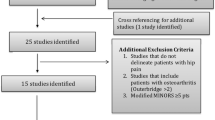Abstract
Background
Femoroacetabular impingement (FAI) is reportedly a prearthritic condition in young adults that can progress to osteoarthritis. However, the prevalence of FAI is unknown in the young, active population presenting with hip complaints.
Questions/purposes
We sought to determine (1) the prevalence of radiographic findings of FAI in a young, active patient population with complaints localized to the region of the hip presenting to primary care and orthopaedic clinics; (2) the percentage of films with FAI with an official reading suggesting the diagnosis; and (3) whether the Tönnis grades of osteoarthritis corresponded to the findings of FAI.
Methods
We performed a database review of pelvic and hip radiographs obtained from 157 young (mean age 32 years; range, 18–50 years) patients presenting with hip-related complaints to primary care and orthopaedic clinics. Radiographs were analyzed for signs of FAI (herniation pits, pistol grip deformity, center-edge angle, alpha angle, and crossover sign) and Tönnis grade. Radiology reports were reviewed for a diagnosis of FAI.
Results
At least one finding of FAI was found in 135 of the 155 patients (87%). Four hundred thirteen of 487 radiographs (85%) had been read as normal and one read as showing FAI. Tönnis grades did not correlate with radiographic signs of FAI.
Conclusions
Radiographic evidence of FAI is common in active patients with hip complaints. Increased awareness of FAI in primary care, radiology, and orthopaedic clinics and additional research into the long-term effects of management are warranted.
Level of Evidence
Level II, diagnostic study. See the Guidelines for Authors for a complete description of levels of evidence.

Similar content being viewed by others

References
Beall DP, Sweet CF, Martin HD, Lastine CL, Grayson DE, Ly JQ, Fish JR. Imaging findings of femoroacetabular impingement syndrome. Skeletal Radiol. 2005;34:691–701.
Beck M, Kalhor M, Leunig M, Ganz R. Hip morphology influences the pattern of damage to the acetabular cartilage: femoroacetabular impingement as a cause of early osteoarthritis of the hip. J Bone Joint Surg Br. 2005;87:1012–1018.
Blankenbaker DG, Tuite MJ. The painful hip: new concepts. Skeletal Radiol. 2006;35:352–370.
Clohisy JC, Carlisle JC, Trousade R, Kim YJ, Beaule PE, Morgan P, Steger-May K, Schoenecker PL, Millis M. Radiographic evaluation of the hip has limited reliability. Clin Orthop Relat Res. 2009;467:666–675.
Clohisy JC, Nunley RM, Otto RJ, Schoenecker PL. The frog-leg lateral radiograph accurately visualized hip cam impingement abnormalities. Clin Orthop Relat Res. 2007;462:115–121.
Ganz R, Parvizi J, Beck M, Leunig M, Notzli H, Siebenrock KA. Femoroacetabular impingement; a cause for osteoarthritis of the hip. Clin Orthop Relat Res. 2003;417:112–120.
Leunig M, Beck M, Dora C, Ganz R. [Femoroacetabular impingement: trigger for the development of coxarthrosis] [in German]. Orthopade. 2006;35:77–84.
Manaster BJ, Zakel S. Imaging of femoral acetabular impingement syndrome. Clin Sports Med. 2006;25:635–657.
Notzli HP, Wyss TF, Stoecklin CH, Schmid MR, Treiber K, Hodler J. The contour of the femoral head-neck junction as a predictor for the risk of anterior impingement. J Bone Joint Surg Br. 2002;84:556–560.
Siebenrock KA, Kalbermatten DF, Ganz R. Effect of pelvic tilt on acetabular retroversion: a study of pelves from cadavers. Clin Orthop Relat Res. 2003;407:241–248.
Tanzer M, Noiseux N. Osseous abnormalities and early osteoarthritis; the role of hip impingement. Clin Orthop Relat Res. 2004;429:170–177.
Tönnis D, Heinecke A. Acetabular and femoral anteversion: relationship with osteoarthritis of the hip. J Bone Joint Surg Am. 1999;81:1747–1770.
Wenger DE, Kendell KR, Miner MR, Trousdale RT. Acetabular labral tears rarely occur in the absence of bony abnormalities. Clin Orthop Relat Res. 2004;426:145–150.
Author information
Authors and Affiliations
Corresponding author
Additional information
Each author certifies that he or she has no commercial associations (eg, consultancies, stock ownership, equity interest, patent/licensing arrangements, etc) that might pose a conflict of interest in connection with the submitted article.
Each author certifies that his or her institution approved or waived approval for the human protocol for this investigation and that all investigations were conducted in conformity with ethical principles of research.
The views expressed in this document are those of the authors and do not reflect the official policy of William Beaumont Army Medical Center, The Department of the Army, or the US government.
About this article
Cite this article
Ochoa, L.M., Dawson, L., Patzkowski, J.C. et al. Radiographic Prevalence of Femoroacetabular Impingement in a Young Population with Hip Complaints Is High. Clin Orthop Relat Res 468, 2710–2714 (2010). https://doi.org/10.1007/s11999-010-1233-8
Received:
Accepted:
Published:
Issue Date:
DOI: https://doi.org/10.1007/s11999-010-1233-8



